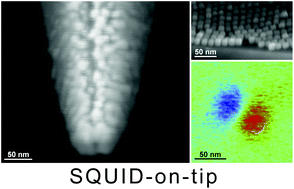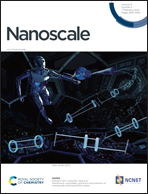SQUID-on-tip with single-electron spin sensitivity for high-field and ultra-low temperature nanomagnetic imaging†
Abstract
Scanning nanoscale superconducting quantum interference devices (nanoSQUIDs) are of growing interest for highly sensitive quantitative imaging of magnetic, spintronic, and transport properties of low-dimensional systems. Utilizing specifically designed grooved quartz capillaries pulled into a sharp pipette, we have fabricated the smallest SQUID-on-tip (SOT) devices with effective diameters down to 39 nm. Integration of a resistive shunt in close proximity to the pipette apex combined with self-aligned deposition of In and Sn, has resulted in SOTs with a flux noise of 42 nΦ0 Hz−1/2, yielding a record low spin noise of 0.29 μB Hz−1/2. In addition, the new SOTs function at sub-Kelvin temperatures and in high magnetic fields of over 2.5 T. Integrating the SOTs into a scanning probe microscope allowed us to image the stray field of a single Fe3O4 nanocube at 300 mK. Our results show that the easy magnetization axis direction undergoes a transition from the 〈111〉 direction at room temperature to an in-plane orientation, which could be attributed to the Verwey phase transition in Fe3O4.



 Please wait while we load your content...
Please wait while we load your content...